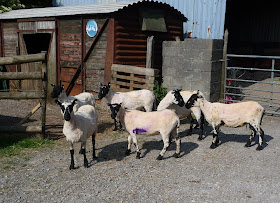My companion, Elinor Gotland, caught me sighing over old photos of my friend Mary’s Speckled Face Beulah sheep.
"You're going to miss those Beulahs, Beaut."
“I am, and Mary, too."
"She's gone to a better place."
I bridled at that.
I bridled at that.
"It may be less rainy in France, but I wouldn't say it was better."
"You think sunshine and grape vines are less appealing than sodden fields and foot rot?"
"Even so, it must have been a real wrench to sell the flock after all these years. Don't they look lovely?"
“Fair play, the Beulahs are photogenic.”
I took this picture the January Mary first invited me to Ty
Cribbwr Farm. Which is pronounced ‘Tee Cribboor’ - you’ll have to make what you
can of Welsh place names when I tell you that for over a hundred years, Speckled
Face Beulah sheep have been pure bred on the hills of Eppynt, Llanafan,
Abergwesyn and Llanwrtyd Wells. Less hardy than the true Welsh Mountain sheep, which may spend all their
lives out on high ground, Beulahs are bigger and comparatively manageable. Importantly for the
farmer, they are excellent mothers. That day, the vet had come to scan Mary’s ewes. Many were carrying twins or triplets and though it pained me to mark their fleeces, my
job was to paint spots on their backs to show which ones were going to need
extra feed during pregnancy.
Mary’s flock started when she was given a Beulah ram lamb
triplet to bring on, because his mother couldn’t manage to feed three. He was nicknamed Boots,
seeing as his legs were black to the knee and white above. The next year, she bought
him a harem of ten Beulah ewes and by the time I met her, the flock had grown to more than a
hundred sheep.
I did love lambing.
"There's a deep satisfaction, watching wet, new born lambs struggle to their hooves for the first time."
"There's a deep satisfaction, watching wet, new born lambs struggle to their hooves for the first time."
"And a hell of a struggle delivering the ones that get stuck at three in the morning. Alright for you, you only did the day shifts. It's all that free wool you'll really miss, Beaut."
True enough, waiting til
summer for the shearing was a perfect agony of anticipation. The clippers
buzzed, sweat beaded and bald ewes bounded away. Beetling about, rather frenzied myself,
skirting and wrapping the fresh fleeces, I had golden opportunities to compare and contrast fibres from several local breeds living on
the farm. All Down types, the Beulah felt far, far less bristly than Welsh
Mountain, though a Lleyn fleece just edged it as the softest wool in the
pile. After skirting, the quality of wool and staple length
across each whole fleece varied only modestly from an average of medium soft
locks, about 10cm long, coarser and straighter over the breech. Elsewhere, the crimp was tight, but disorganised,
with a low lanolin content. Not only
resistant to felting in the wash, the clean locks were a pleasure to comb for spinning
worsted and even the raw wool was light work to hand card for long draw
spinning, which is my preferred method.
“I do love it when you can just get straight into a freshly shorn fleece
and spin away with hardly any waste, Elinor. In my opinion, Beulah would be an
ideal choice for a beginner. I had no trouble with any of the preparation and
the fibres are good and grabby to spin.”
“No trouble with preparation?
You rarely did any and you’re fooling no-one, you Slack Alice."
Last year was grievous, a spell of flooding kept the ewes on limited grazing for several weeks, which caused a weak point in the staple. This summer's shearling fleeces were excellent quality, I have just finished spinning one for the Tour de Fleece and am torn whether to snaffle just one more, before the woolsack goes to the Wool Board.
I did do proper sampling and studying, a few years ago when I brought home my first Beulah fleece. The wool was easy to manage and straightforward to spin, from high
twist, worsted fingering weight to low twist, woollen chunky. Pale cream rather than bright white, all types
of yarn were much softer than I anticipated, being accustomed to Welsh hill
breeds, which are best suited to making bags and rugs. As you would expect,
given more time and effort, combed worsted yarn came out slicker and smoother,
knitting up with a bit of a gleam and more drape. Minimal kemp meant no itchy
ends were exposed by simply hand carding rolags from the whole locks and Beulah
seemed at its best as a woollen yarn, full, bouncy and elastic, knitting up
into a thoroughly cuddly fabric.
"Maybe Mary will wear that Beulah jumper I knitted, if it gets cool in the evenings, sitting on her French veranda. Maybe the meadowsweet dye will remind her of her damp Welsh valley."
Elinor looked at me.
"Meadowsweet loves it wet, but face it, Beaut, Mary doesn't."







No comments:
Post a Comment